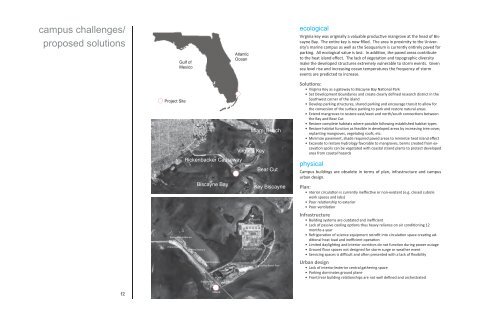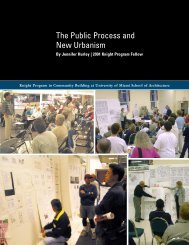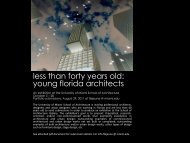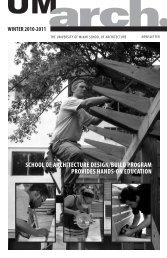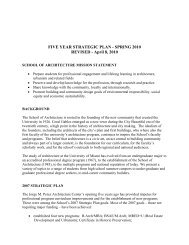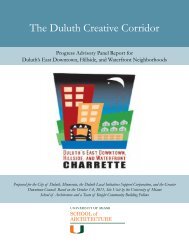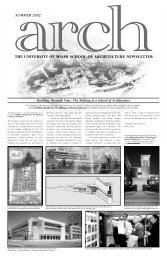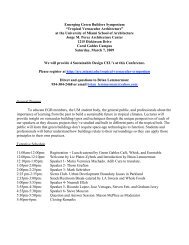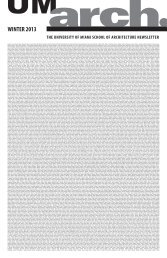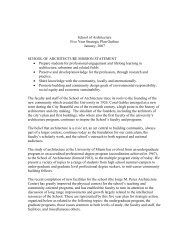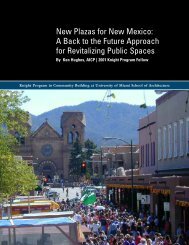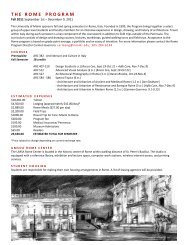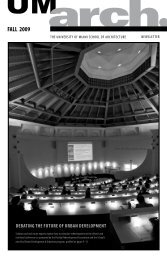Resilience - University of Miami School of Architecture
Resilience - University of Miami School of Architecture
Resilience - University of Miami School of Architecture
You also want an ePaper? Increase the reach of your titles
YUMPU automatically turns print PDFs into web optimized ePapers that Google loves.
campus challenges/<br />
proposed solutions<br />
Gulf <strong>of</strong><br />
Mexico<br />
Atlantic<br />
Ocean<br />
ecological<br />
Virginia key was originally a valuable producve mangrove at the head <strong>of</strong> Biscayne<br />
Bay. The enre key is now filled. The area in proximity to the <strong>University</strong>’s<br />
marine campus as well as the Seaquarium is currently enrely paved for<br />
parking. All ecological value is lost. In addion, the paved areas contribute<br />
to the heat island effect. The lack <strong>of</strong> vegetaon and topographic diversity<br />
make the developed structures extremely vulnerable to storm events. Given<br />
sea level rise and increasing ocean temperatures the frequency <strong>of</strong> storm<br />
events are predicted to increase.<br />
Project Site<br />
<strong>Miami</strong> Beach<br />
<strong>Miami</strong><br />
Virginia Key<br />
Rickenbacker Causeway<br />
Bear Cut<br />
Biscayne Bay<br />
Key Biscayne<br />
Land-Fill<br />
Rickenbacker Marina<br />
Hobie Beach<br />
Marine Stadium<br />
Wastewater Plant<br />
Mast Academy<br />
Virginia Key Beach Park<br />
NOAA<br />
Seaquarium<br />
NMFS<br />
Soluons:<br />
• Virginia Key as a gateway to Biscayne Bay Naonal Park<br />
• Set Development Boundaries and create clearly defined research district in the<br />
Southwest corner <strong>of</strong> the island<br />
• Develop parking structures, shared parking and encourage transit to allow for<br />
the conversion <strong>of</strong> the surface parking to park and restore natural areas<br />
• Extend mangroves to restore east/west and north/south connecons between<br />
the Bay and Bear Cut<br />
• Restore complete habitats where possible following established habitat types<br />
• Restore habitat funcon as feasible in developed areas by increasing tree cover,<br />
replanng mangroves, vegetang ro<strong>of</strong>s, etc.<br />
• Minimize pavement, shade required paved areas to minimize heat island effect<br />
• Excavate to restore hydrology favorable to mangroves, berms created from excavaon<br />
spoils can be vegetated with coastal strand plants to protect developed<br />
area from coastal hazards<br />
physical<br />
Campus buildings are obsolete in terms <strong>of</strong> plan, infrastructure and campus<br />
urban design.<br />
Plan:<br />
• nterior circulaon is currently ineffecve or non-existent (e.g. closed cubicle<br />
work spaces and labs)<br />
• Poor relaonship to exterior<br />
• Poor venlaon<br />
Infrastructure<br />
• Building systems are outdated and inefficient<br />
• Lack <strong>of</strong> passive cooling opons thus heavy reliance on air condioning 12<br />
months a year<br />
• Refrigieraon <strong>of</strong> science equipment retr<strong>of</strong>it into circulaon space creang addional<br />
heat load and inefficient operaon<br />
• Limited daylighng and interior corridors do not funcon during power outage<br />
• Ground floor spaces not designed for storm surge or weather event<br />
• Servicing spaces is difficult and oen presented with a lack <strong>of</strong> flexibility<br />
Urban design<br />
• Lack <strong>of</strong> interior/exterior central gathering space<br />
• Parking dominates ground plane<br />
• Front/rear building relaonships are not well defined and orchestrated<br />
f2<br />
RSMAS


